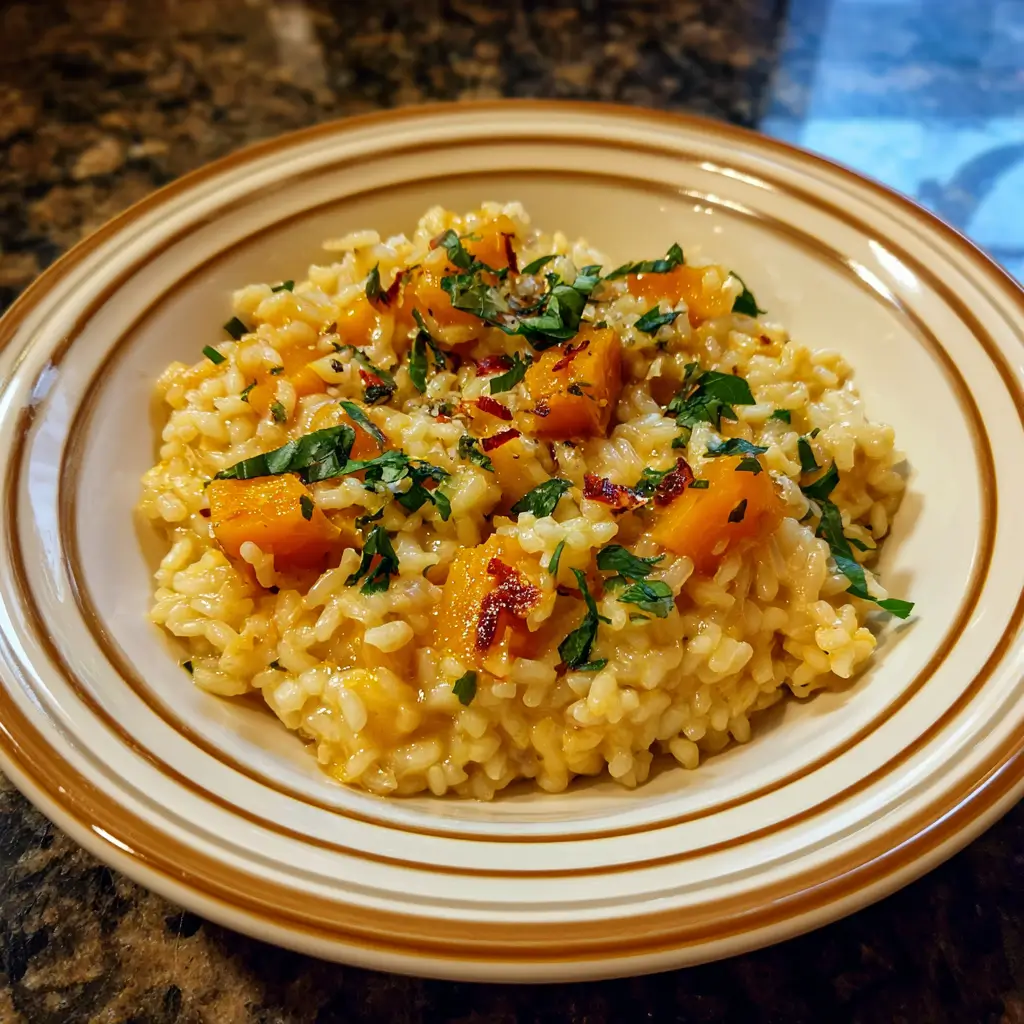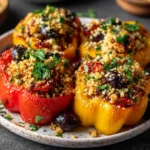Introduction
Butternut squash risotto is a creamy, comforting, and elegant dish that brings the warmth of autumn to your table. With its velvety texture, sweet earthy flavor, and rich golden hue, this risotto is more than just a side—it’s a celebration of seasonal produce and Italian culinary tradition. Whether served as a main course for a cozy dinner or as an impressive starter at a holiday gathering, butternut squash risotto strikes the perfect balance between indulgence and nourishment. This recipe combines the nutty richness of Arborio rice with the natural sweetness of roasted butternut squash, creating a harmonious blend that delights the senses and satisfies the soul.
The History
Risotto, a quintessential Italian dish, originated in northern Italy—particularly in regions like Lombardy, Piedmont, and Veneto—where the climate supports rice cultivation. Unlike pasta, which dominates much of southern Italian cuisine, risotto showcases the north’s agricultural reliance on rice paddies. The technique behind risotto involves slowly cooking short- or medium-grain rice (typically Arborio, Carnaroli, or Vialone Nano) in broth, stirring continuously to release the starch and achieve a luxuriously creamy consistency without becoming mushy.
While traditional risottos often feature ingredients like saffron (as in Risotto alla Milanese), mushrooms, or seafood, seasonal vegetables have increasingly found their place in modern variations. Butternut squash, native to North America but now widely grown across Europe, has become a beloved addition to risotto due to its smooth texture and sweet flavor. Though not part of ancient Italian cookery, butternut squash risotto emerged as a popular fusion of New World produce and Old World technique, especially during the late 20th and early 21st centuries as global ingredients became more accessible. Today, it stands as a staple of fall and winter menus in both homes and fine dining establishments.
Ingredients Breakdown
The magic of butternut squash risotto lies in the quality and synergy of its ingredients. Each component plays a crucial role in building layers of flavor, texture, and aroma:
- Arborio Rice: This short-grain rice is high in amylopectin starch, which gives risotto its signature creaminess when stirred slowly into simmering broth.
- Butternut Squash: Sweet, tender, and vibrant orange, butternut squash adds natural sugars, color, and body. Roasting enhances its caramelized depth.
- Onion and Garlic: Provide aromatic foundation; yellow onion offers mild sweetness, while garlic adds pungency and complexity.
- Dry White Wine: Deglazes the pan and introduces acidity, balancing the richness and lifting other flavors. Choose a crisp variety like Pinot Grigio or Sauvignon Blanc.
- Vegetable or Chicken Broth: Slowly incorporated to cook the rice; warm broth ensures even absorption. Homemade stock elevates the dish significantly.
- Butter and Olive Oil: Butter contributes silkiness and richness, while olive oil adds fruitiness and helps prevent scorching during sautéing.
- Grated Parmesan Cheese: Adds umami, saltiness, and additional creaminess. Authentic Parmigiano-Reggiano is ideal.
- Fresh Herbs: Sage and thyme complement the squash beautifully; sage lends an earthy, slightly peppery note, while thyme provides subtle floral undertones.
- Salt and Black Pepper: Essential seasonings that enhance all other components.
- Nutmeg (optional): A pinch deepens warmth and complements the squash’s sweetness.
- Heavy Cream (optional): For extra decadence, though many purists omit it in favor of starchy broth and cheese.
Step-by-Step Recipe
- Roast the Butternut Squash: Preheat oven to 400°F (200°C). Peel, seed, and dice one medium butternut squash into ¾-inch cubes. Toss with 1½ tablespoons olive oil, salt, pepper, and a pinch of dried thyme. Spread on a parchment-lined baking sheet and roast for 25–30 minutes, flipping halfway, until golden and fork-tender. Remove and set aside.
- Prepare the Broth: In a saucepan, heat 6 cups of vegetable or chicken broth over medium-low heat. Keep it warm throughout the cooking process—this is essential for proper rice absorption.
- Sauté the Aromatics: In a large, heavy-bottomed skillet or Dutch oven, heat 1 tablespoon olive oil and 1 tablespoon unsalted butter over medium heat. Add 1 finely chopped yellow onion and cook gently for 5–7 minutes until translucent and soft (do not brown). Stir in 2 minced garlic cloves and cook for 30 seconds until fragrant.
- Toast the Rice: Add 1½ cups Arborio rice to the pot. Stir constantly for 2–3 minutes until each grain becomes slightly opaque and smells nutty. This step seals the rice and prevents mushiness.
- Deglaze with Wine: Pour in ½ cup dry white wine. Stir continuously as the liquid bubbles and evaporates, scraping up any flavorful bits from the bottom of the pan. Cook until the wine is fully absorbed.
- Add Broth Gradually: Begin adding warm broth one ladleful (about ½ cup) at a time. Stir frequently and allow each addition to be mostly absorbed before adding the next. This slow process takes about 18–22 minutes. The rice should remain al dente—tender with a slight bite—and the mixture will look creamy and loose, not stiff.
- Incorporate the Squash: When the rice is nearly done (after about 15 minutes of broth additions), gently fold in the roasted butternut squash. Continue adding broth and stirring until the rice reaches the desired texture.
- Finish the Risotto: Remove from heat. Stir in ¼ cup grated Parmesan cheese, 1 tablespoon cold butter, and a handful of fresh sage leaves (chopped). Season with salt, black pepper, and a tiny pinch of ground nutmeg if desired. Cover and let rest for 2 minutes—this allows the risotto to absorb final moisture and develop creaminess.
- Serve Immediately: Spoon into warmed bowls. Garnish with extra Parmesan, cracked black pepper, fried sage leaves, pumpkin seeds, or microgreens for added texture and visual appeal.
Tips
- Keep the Broth Warm: Adding cold broth slows down cooking and disrupts starch release. Use a separate saucepan to keep it steaming hot.
- Stir Often, But Not Constantly: Frequent stirring encourages starch release, but you don’t need to stir nonstop. Just make sure to stir every 30–60 seconds to prevent sticking.
- Taste as You Go: Start tasting the rice after 15 minutes. It should be creamy yet firm to the bite (al dente). Overcooking leads to mush.
- Don’t Rush the Process: Risotto takes time—usually 20–25 minutes from start to finish. Rushing by adding too much broth at once results in uneven texture.
- Use Quality Ingredients: Freshly grated Parmesan, real butter, and homemade broth make a noticeable difference.
- Roast, Don’t Steam: Roasting the squash intensifies flavor through caramelization, whereas boiling or steaming can waterlog it.
- Rest Before Serving: Letting the risotto sit covered for 1–2 minutes after cooking improves mouthfeel and creaminess.
- Serve Right Away: Risotto waits for no one! It thickens quickly as it cools, so serve immediately after finishing.
Variations and Customizations
One of the joys of butternut squash risotto is its adaptability. Here are some creative ways to personalize the dish:
- Creamier Version: Stir in 2–3 tablespoons of mascarpone or heavy cream at the end for an ultra-luxurious texture.
- Protein Boost: Add cooked pancetta, crispy bacon, grilled chicken, or seared shrimp for a heartier meal.
- Vegan Option: Omit butter and cheese; use coconut oil or vegan margarine and nutritional yeast for cheesy flavor. Ensure broth is plant-based.
- Gluten-Free Friendly: Naturally gluten-free as long as all ingredients (especially broth and wine) are certified GF.
- Herb Swaps: Replace sage with rosemary, thyme, or even a touch of tarragon for different aromatic profiles.
- Nutty Crunch: Top with toasted walnuts, pecans, or pine nuts for contrast.
- Spicy Kick: Add red pepper flakes or a drizzle of chili oil before serving.
- Other Squashes: Substitute butternut with kabocha, acorn, or pumpkin for similar results.
- Truffle Elevation: Drizzle with truffle oil or shave fresh black truffle on top for gourmet flair.
- Seafood Twist: Combine with scallops or lobster for a luxurious autumn surf-and-turf risotto.
Health Considerations and Nutritional Value
Butternut squash risotto can be both satisfying and nutritious when prepared thoughtfully. While traditionally rich due to butter and cheese, mindful modifications can improve its health profile without sacrificing flavor.
Nutritional Highlights:
- Butternut Squash: Low in calories and packed with beta-carotene (vitamin A), vitamin C, potassium, fiber, and antioxidants. Supports eye health, immunity, and digestion.
- Arborio Rice: A source of carbohydrates and energy. Lower in fiber than whole grains, but still provides B vitamins and iron.
- Olive Oil: Rich in heart-healthy monounsaturated fats and anti-inflammatory compounds.
- Garlic and Onions: Contain allicin and quercetin, known for immune-boosting and anti-inflammatory properties.
- Parmesan Cheese: Offers protein, calcium, and savory umami, though it’s high in sodium and saturated fat—moderation is key.
Ways to Make It Healthier:
- Reduce butter and cheese or use lower-fat alternatives.
- Increase vegetable content by adding spinach, kale, or mushrooms.
- Use low-sodium broth to control salt levels.
- Substitute half the Arborio rice with cauliflower rice for a lower-carb version (note: texture will change).
- Serve in moderate portions (½ to 1 cup) alongside a green salad or roasted vegetables for balanced nutrition.
Approximate Nutritional Values (per serving, serves 6):
- Calories: 320–380
- Fat: 12–16g (mostly from healthy sources)
- Carbohydrates: 45–50g
- Protein: 8–10g
- Fiber: 4–6g
- Vitamin A: Over 200% DV (thanks to squash)
- Vitamin C: ~50% DV
Ingredients
- 1 medium butternut squash (about 2 lbs), peeled, seeded, and cubed
- 2 tbsp olive oil, divided
- Salt and freshly ground black pepper, to taste
- 1 tsp dried thyme (or 1 tbsp fresh)
- 6 cups vegetable or chicken broth
- 1 tbsp unsalted butter
- 1 medium yellow onion, finely chopped
- 2 garlic cloves, minced
- 1½ cups Arborio rice
- ½ cup dry white wine (e.g., Pinot Grigio)
- ¼ cup grated Parmesan cheese (plus more for serving)
- 1 tbsp cold unsalted butter (for finishing)
- ½ cup fresh sage leaves, chopped (reserve a few whole leaves for frying)
- Pinch of ground nutmeg (optional)
Directions
- Preheat oven to 400°F (200°C). Toss butternut squash cubes with 1½ tbsp olive oil, salt, pepper, and thyme. Spread on a baking sheet and roast for 25–30 minutes, flipping once, until tender and lightly caramelized. Set aside.
- Warm the broth in a saucepan over low heat; keep it simmering gently.
- In a large pot or deep skillet, heat ½ tbsp olive oil and 1 tbsp butter over medium heat. Add onion and cook until soft and translucent (5–7 minutes). Add garlic and cook 30 seconds more.
- Add Arborio rice and toast for 2–3 minutes, stirring constantly, until grains are coated and slightly translucent.
- Pour in white wine and stir until completely absorbed, about 2 minutes.
- Begin adding warm broth one ladle (½ cup) at a time, stirring frequently. Wait until most liquid is absorbed before adding the next portion. Continue for 18–22 minutes.
- After 15 minutes, gently stir in roasted butternut squash.
- When rice is creamy and al dente, remove from heat. Stir in Parmesan, 1 tbsp cold butter, chopped sage, and nutmeg (if using). Cover and rest 2 minutes.
- Meanwhile, fry a few sage leaves in olive oil for garnish (optional): Heat 1 tsp oil in a small pan, add sage leaves, and cook 10–15 seconds per side until crisp.
- Serve immediately, topped with extra Parmesan, cracked pepper, fried sage, and/or pumpkin seeds.
FAQ
Can I make butternut squash risotto ahead of time?
It’s best served fresh, but you can prepare components in advance. Roast the squash and warm the broth ahead. Cook the risotto just before serving, as reheating makes it gluey. If needed, reheat gently with a splash of broth.
Can I freeze butternut squash risotto?
Freezing is not recommended due to texture changes—rice becomes overly soft and mushy upon thawing. Store leftovers in the refrigerator for up to 3 days and reheat carefully.
What can I use instead of white wine?
Substitute with additional broth mixed with 1 tbsp lemon juice or 1 tsp apple cider vinegar for acidity. Avoid skipping entirely, as wine adds important flavor complexity.
Is risotto gluten-free?
Yes, provided that the broth, wine, and all additives are certified gluten-free. Arborio rice is naturally gluten-free.
Why is my risotto gummy or sticky?
This usually happens when too much liquid is added too quickly or the rice is overcooked. Always add broth gradually and taste for doneness.
Can I use instant or pre-cooked rice?
No—Arborio must be cooked slowly to release starch. Instant rice won’t yield the correct texture.
How do I know when risotto is done?
The rice should be tender with a slight resistance (al dente), and the overall consistency should be creamy and flow slightly (“all’onda” — wavy). It shouldn’t be stiff or soupy.
Can I make this vegan?
Absolutely! Use olive oil instead of butter, omit Parmesan or use a plant-based alternative, and ensure the broth is vegan-friendly.
Summary
Butternut squash risotto is a luscious, seasonal dish that blends Italian culinary finesse with the natural sweetness of roasted squash for a comforting yet sophisticated meal. Perfect for fall dinners, holidays, or impressing guests, this creamy, aromatic risotto delivers rich flavor and wholesome goodness in every bite.










